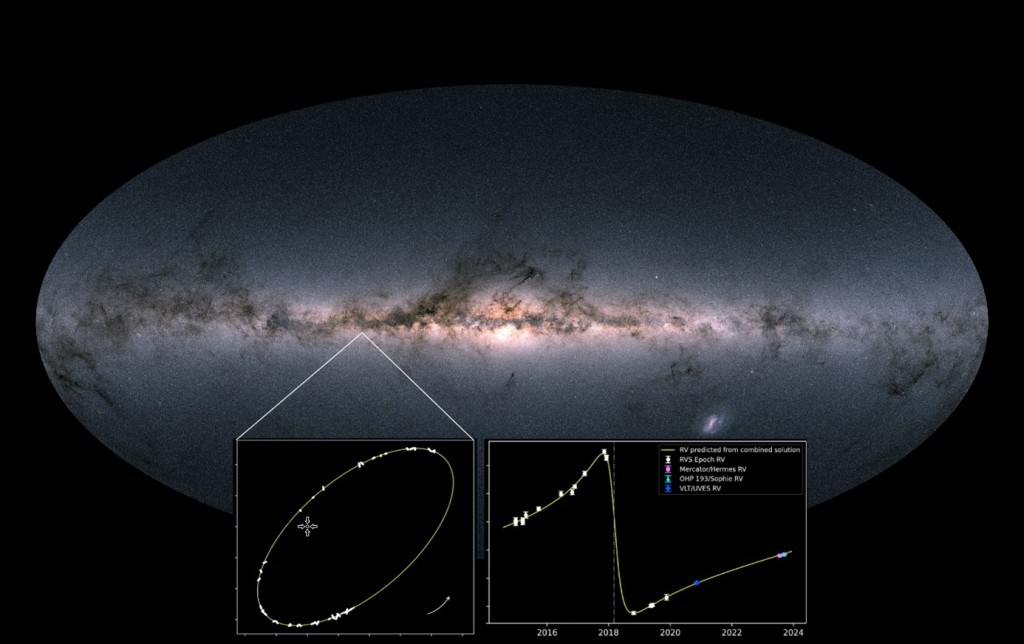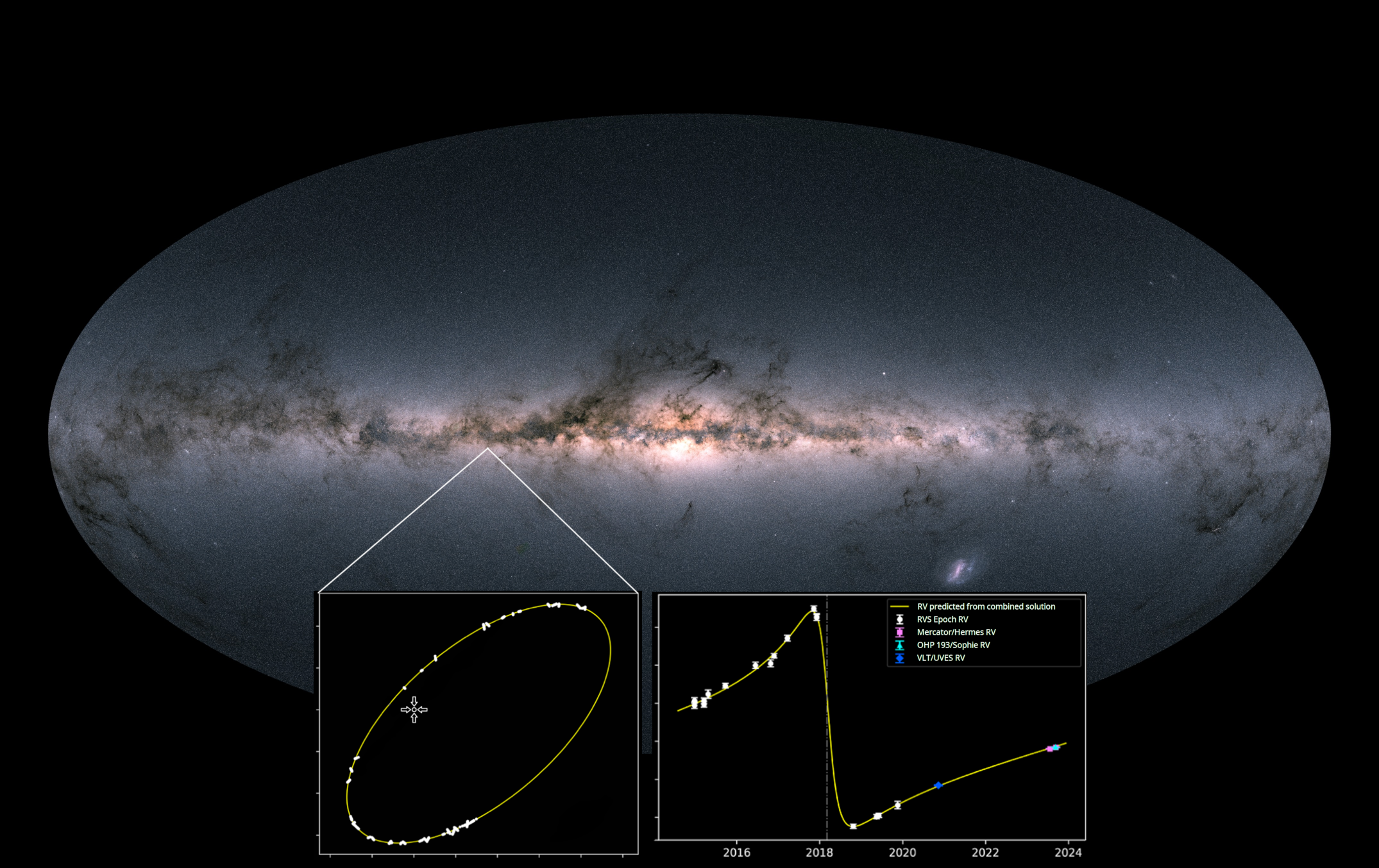New Black Hole discovered with ESA’s Gaia satellite
Brussels, 16 April 2024 – Today the European Space Agency (ESA) and the Gaia collaboration teams reveal the discovery of a high-mass stellar black hole of 33 times our Sun’s mass in the Milky Way. The Royal Observatory of Belgium contributed to this discovery thanks to the radial velocity data it helped to process.
Third black hole discovered with Gaia data
A stellar black hole results from the sudden collapse and subsequent supernova explosion of a heavy star at the very end of its short life, after consuming all its fuel. Gaia observed the new black hole in a system of two stars bound together by gravity (called a binary star) in the inner halo of the Milky Way, a spherical cloud of evolved stars surrounding its centre. It is the third stellar black hole discovered by Gaia. The first two are also part of binary star systems.
The Gaia data reveal this new black hole is composed of a giant companion star and a stellar black hole of about 33 times the solar mass. Because it is the third black hole identified with Gaia data, this particular binary was baptised Gaia BH3.
The new discovery was made last March by a large international team of about 450 researchers collaborating in Gaia’s Data Processing & Analysis Consortium. The DPAC is currently preparing its fourth data release, the latest version of the Gaia Data Catalogue expected by 2026. Five research institutions in Belgium are contributing to this release and are supported by the Belgian Science Policy Office (BELSPO); the Royal Observatory of Belgium (ROB), Katholieke Universiteit Leuven (KU Leuven), Université Libre de Bruxelles (ULB), Université de Liège (ULiège), and Universiteit Antwerpen (UAntwerpen).

Map of the Galaxy observed by Gaia. The new stellar black hole Gaia BH3 has been discovered in the inner halo of the Milky Way in the constellation of Aquila. The left-hand inset panel shows the position against the sky of the giant companion star observed by Gaia at different times (white symbols). The yellow line shows its astrometric orbit with respect to the coordinates of the black hole marked with four arrows. The right-hand inset panel shows the radial velocity curve. White dots mark the Gaia DPAC measurements. The yellow curve is the best fitting (spectroscopic) orbital solution for the radial velocity of the giant companion star. Other radial velocity data (colored symbols) from ground-based telescopes confirm the high-mass black hole discovery. Image credits: ESA/Gaia/DPAC.
Discovery confirmed with other observations
The discovery of a new black hole is not entirely unexpected because Gaia’s data processing is designed to automatically flag special cases by combining all data observed over several consecutive years. The Gaia´s data processing team at ULB compared Gaia’s astrometric and spectroscopic data for calculating the masses and luminosities of stars in binary systems. They identified Gaia BH3 as a new binary with one component star having zero brightness, but with a whopping 33 solar masses. These properties are consistent with a stellar black hole. Gaia’s high-resolution spectra are calibrated and used in DPAC for accurate measurements of the radial velocity (RV) of stars, in this case that of the visible giant star in Gaia BH3. Scientists of the ROB, ULiège, and UAntwerpen are actively contributing to these precise RV measurements in the DPAC.
Previous research shows that a black hole in a binary system is in itself not surprising. More than half of all stars in the Milky Way are binary or multiple systems. The component stars orbit a common center of gravity but do not evolve at the same pace depending on their weight.
The discovery of a new high-mass black hole has already been confirmed by other observations using telescopes on Earth. The DPAC teams combined the spectra of three European telescopes at La Palma in Spain (Hermes spectrograph on the Mercator telescope), in France at Observatoire de Haute-Provence and in Chile (ESO: Very Large Telescope). For accurate RV measurements, the Mercator telescope uses the Hermes spectrograph, developed thanks to the collaboration of three Belgian research institutions (KU Leuven, ULB, ROB) that also contribute to its daily operations.
Heavy black hole born from a massive metal-poor star
The theory modelling stellar evolution still fails to explain the heavy black hole in Gaia BH3. An important new aspect revealed by this high-mass stellar black hole discovery and Gaia’s high-resolution spectra is that the atmosphere of the giant star accompanying the black hole contains very few metals. It is an old giant star composed mainly of hydrogen and helium, typical for the stars in the galactic halo. It confirms that the progenitors of massive stellar black holes are also metal poor. This specific chemical composition would explain why they were more compact and have lost less mass than usually observed.
Gaia’s spectra indeed show that the old giant star has not been enriched with metals during the explosion of its companion before the heavy black hole was formed. This discovery shows for the first time that such a heavy stellar black hole may have been created by the collapse and explosion of a massive metal-poor star, which evolved very differently from the massive stars observed in the Milky Way galaxy today.
Links
These results are described in the paper “Discovery of a dormant 33 solar-mass black hole in pre-release Gaia astrometry by Gaia Collaboration” (Gaia Collaboration, P. Panuzzo et al.) published in Astronomy & Astrophysics: https://aanda.org/10.1051/0004-6361/202449763
ESA press release: https://www.esa.int/Science_Exploration/Space_Science/Gaia/Sleeping_giant_surprises_Gaia_scientists

